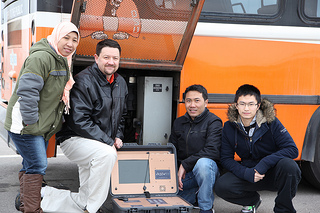Oklahoma State University to quantify the benefits of going green
Friday, March 8, 2013
The benefits of Oklahoma State University changing from diesel to natural gas transit buses will soon be characterized and quantified in a study by Dr. Phil Lewis, assistant professor in OSU’s School of Civil and Environmental Engineering. OSU’s Parking and Transit Services Department has given Dr. Lewis the green light to study the benefits of burning clean.
“People say that natural gas is a cleaner burning fuel; and I agree with that,” said Lewis. “But a lot of information we have about the benefits of natural gas is anecdotal. We don’t really know how much cleaner it is.”
OSU began the process of changing its bus fleet from diesel to natural gas in 2010. Twenty new natural gas vehicles have been purchased. Only 15 diesel buses remain, and natural gas buses will also eventually replace those. Dr. Lewis will be comparing the difference in air pollutant emissions between the diesel buses and the natural gas buses.
OSU Transit Services Manager Thomas Duncan said the natural gas buses are providing financial savings in fuel costs as well as providing healthier service with the cleaner-burning fuel. Duncan said it will be interesting to see in Dr. Lewis’ study exactly how much better for the environment the natural gas buses are as compared to the diesel buses.
Lewis said his upcoming project to quantify the benefits of natural gas in OSU’s buses is an extension of the doctoral research he conducted at North Carolina State University. In his doctoral research, Dr. Lewis characterized and quantified emissions from heavy-duty diesel construction equipment.
Lewis said the overall goal of his research is to improve economic and environmental sustainability.
“I look at the economic sustainability: Where do we get money to replace this equipment? I look at energy sources: Heavy equipment consumes a lot of fuel, especially diesel fuel, which is a petroleum project, so how long can we keep going with that? That’s why we have to look at other fuels, like biofuels and natural gas, and even electricity. And another important component is: How can we reduce the pollution from this equipment?”
Lewis feels this research will help provide answers to these important questions, while solidifying OSU’s decision to go green with transportation.

